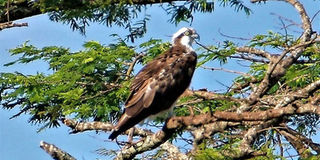A walk through Juja

Rupi Mangat and friends explore the Thika area in search of fascinating bird species. PHOTO| RUPI MANGAT
What you need to know:
- We stop by a gorgeous green wooded grassland.
In the midst of the homes and fences in and around the wetlands, a pair of endangered Grey-crowned cranes stalk to feed on the frogs and other small creatures that breed in them.
When Elspeth Huxley penned the Flame Trees of Thika, the road out of Nairobi in 1913 was very much different from the Thika super highway we are driving on to reach Juja, 40 kilometres away.
Her description from the novel is of her as a six-year old with her mother, on an ox wagon, travelling out of Nairobi to meet her father who has just acquired virgin land that’s deemed to be great for coffee farming.
Beyond Ainsworth Bridge it was open country with wild game like lions on it. Giraffes on the grass plains and antelopes watched the little party inch its way to reach Thika in two days.
Just over 100 years later, it’s urban living all along the fast highway.
Our route diverges a few kilometres before Thika and on to a country lane. We’re heading to Juja for a day of hiking and birding with Nature Kenya. The country lane is red murram straddled by coffee farms patched with grass plains dotted with acacias in flower.
“The land between Nairobi and Thika, now fast becoming built up, is particularly rich in biodiversity,” says Fleur Ng’weno, who started the bird walks from the car park at Nairobi Museum in 1972.
“There are a number of plant species that are only found in the Nairobi-Thika area,” she continues. “That’s why it’s so important to conserve green spaces as the city builds up.”
We stop by a gorgeous green wooded grassland. In the midst of the homes and fences in and around the wetlands, a pair of endangered Grey-crowned cranes stalk to feed on the frogs and other small creatures that breed in them.
LARGE, HANDSOME RAPTOR
Suddenly someone spots an osprey on the top of a tall tree and all binoculars are excitedly trained to it. The osprey is a large, handsome raptor and a visitor from the northern hemisphere.
Perched on the tree above the wetlands is a great vantage point for it to scan the natural pools for food like frogs.
Sidney Shema, an ornithologist working with the Kenya Bird Map project, gives an impromptu talk on the migrants.
“Africa receives many species of birds that migrate from Eurasia (Europe and Asia) every year. These are called Palearctic migrants. They spend several months in Africa to escape the harsh Eurasian winter. They then return to Eurasia to breed during the summer.
“Several of these migrants enter and leave Africa through narrow 'corridors' called bottlenecks. These are areas that minimise the distance that the birds have to fly over the sea between the African and Eurasian continents. The bottlenecks are like the Sinai Peninsula linking Egypt and Israel, or the Strait of Gibraltar between Spain and Morocco.
“The thing is,” continues our bird-man, “that the flight patterns of Palearctic migrants have been studies extensively and are known. But little is known of birds that migrate within Africa.”
BUILT TO LAST FOR GENERATIONS
A leisurely hour later, we’re driving in through the gates of Ziwani, a coffee farm cum guest house on the Karakuta-Gacibi estate. Charles Kibe of Ziwani gives an introduction to the farm.
“Coffee farming was established by the colonialists who also built the house,” says Kibe. “The house was built to last for generations with walls two feet thick.” However, the fortune in coffee farming is dwindling.
“Most of the coffee has been uprooted and replaced with boma Rhodes grass, avocados, herbs and tomato farming. But we still have some Ruiru 11 and Batian coffee varieties which are disease-resistant.
Past the green lawn, a narrow path leads us to Ndarugo, a subterranean river. It’s a stunning gorge strewn with gigantic rocks carpeted with lush moss and a river forest. “The river runs along the farm for about 2.5 kms and disappears underground for a kilometre to re-emerge on the neighbour’s farm,” explains Kibe.
Driving back in the late afternoon, the osprey is on the same tree, resting before it takes to the skies again.
www.rupitheafricantrotter.wordpress.com




